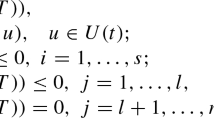Abstract
The genesis of the Lagrange multipliers is analyzed in this work. Particularly, the author shows that this mathematical approach was introduced by Lagrange in the framework of statics in order to determine the general equations of equilibrium for problems with constraints. Indeed, the multipliers allowed Lagrange to treat the questions of maxima and minima in differential calculus and in calculus of variations in the same way as problems of statics: if the equilibrium of a point or a system of points is required, there is an analogy between statics and differential calculus; if the equilibrium of a rigid body is required, there is an analogy between statics and calculus of variations.
Similar content being viewed by others
Reference
Lagrange, J. L., Mécanique Analitique, Complete Edition, joining the notes of the 3rd Edition revised, corrected, and annotated by Joseph Bertrand, and those of the 4th Edition published under the direction of Gaston Darboux; Albert Blanchard, Paris, France, 1965.
Author information
Authors and Affiliations
Rights and permissions
About this article
Cite this article
Bussotti, P. On the Genesis of the Lagrange Multipliers. Journal of Optimization Theory and Applications 117, 453–459 (2003). https://doi.org/10.1023/A:1023952102705
Issue Date:
DOI: https://doi.org/10.1023/A:1023952102705




